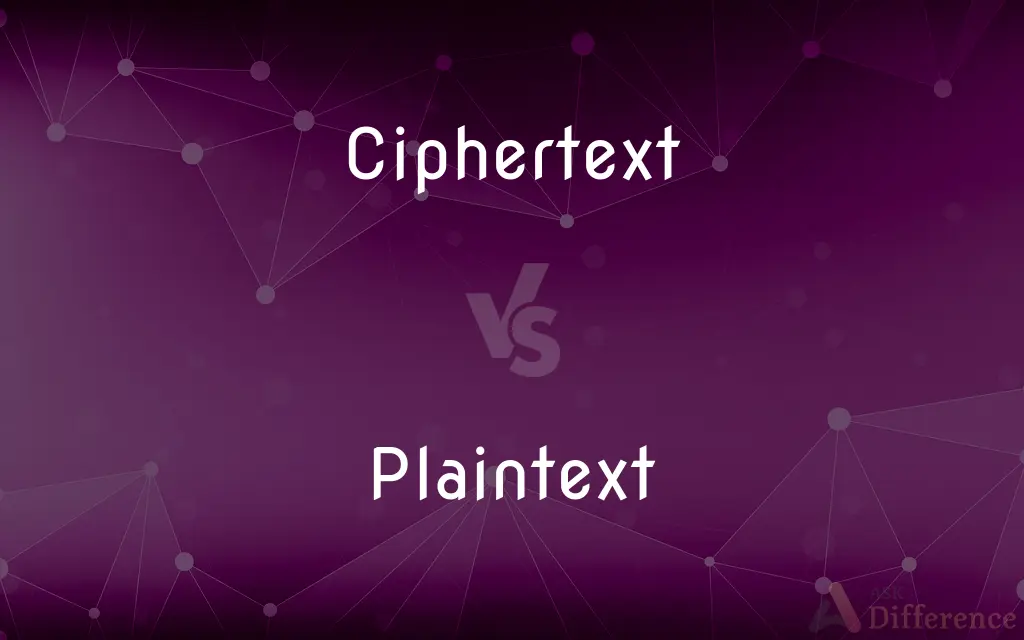Ciphertext vs. Plaintext — What's the Difference?
Edited by Tayyaba Rehman — By Urooj Arif — Updated on March 11, 2024
Ciphertext is encrypted text transformed from plaintext using an algorithm, whereas plaintext is readable text before encryption.

Difference Between Ciphertext and Plaintext
Table of Contents
ADVERTISEMENT
Key Differences
Ciphertext is the result of the encryption process, where plaintext is converted using a cipher into a format that cannot be easily understood without the key. This ensures data security and privacy. Plaintext, on the other hand, is clear, readable text that has not been encrypted. It is the original message or data that is input into an encryption algorithm to produce ciphertext.
Encryption algorithms transform plaintext into ciphertext to protect the confidentiality of the information. This process involves various techniques and keys to ensure that only authorized parties can decrypt the ciphertext back into plaintext. While plaintext is easily readable and understandable by humans and computers alike, ciphertext is designed to be unreadable and nonsensical to anyone who does not have the decryption key.
The transition from plaintext to ciphertext is crucial in securing communication and data storage. Plaintext may contain sensitive information such as personal details, passwords, or confidential communication, which needs to be protected. Ciphertext, therefore, serves as a secure form of this information, mitigating the risk of unauthorized access or interception.
Plaintext and ciphertext are two states of data in the context of cryptography. Plaintext is the original, unencrypted data that is clear and readable, while ciphertext is the encrypted, secure form of that data, which requires a key to be decrypted back into plaintext. The encryption process ensures the confidentiality and integrity of the information as it is stored or transmitted.
Comparison Chart
Nature
Encrypted, unreadable format
Original, readable format
ADVERTISEMENT
Purpose
Ensures data security and privacy
Conveys clear, understandable information
Usage
Stored or transmitted securely
Input into encryption algorithms
Readability
Not readable without decryption key
Easily readable and understandable
Key Requirement
Requires a key for decryption
No key required for reading
Compare with Definitions
Ciphertext
Encrypted text that results from the application of a cipher to plaintext.
After encryption, the message was converted into ciphertext to prevent unauthorized access.
Plaintext
The original form of data before any encryption has taken place.
Sensitive information should not be stored in plaintext to avoid security breaches.
Ciphertext
A form of data that ensures privacy and security by being unreadable without the correct decryption key.
The ciphertext was securely transmitted over the internet, protecting the information from eavesdroppers.
Plaintext
Input for encryption algorithms to generate ciphertext.
The encryption software converted the plaintext message into secure ciphertext.
Ciphertext
Often appears as random characters, providing no insight into the original content without decryption.
To the untrained eye, the ciphertext appeared as a series of nonsensical characters.
Plaintext
Lacks the security features of ciphertext, making it vulnerable to unauthorized access.
Storing passwords in plaintext is a significant security risk.
Ciphertext
The product of various encryption algorithms and techniques.
Advanced encryption algorithms transformed the sensitive data into secure ciphertext.
Plaintext
Unencrypted text that is clear and easily understandable.
The email was composed in plaintext before being encrypted for secure transmission.
Ciphertext
Can be decrypted back into plaintext by authorized parties who possess the necessary key.
With the decryption key, the recipient converted the ciphertext back into readable plaintext.
Plaintext
Readable by both humans and computers without the need for decryption.
The document was saved in plaintext, making it accessible to anyone who opened it.
Ciphertext
In cryptography, ciphertext or cyphertext is the result of encryption performed on plaintext using an algorithm, called a cipher. Ciphertext is also known as encrypted or encoded information because it contains a form of the original plaintext that is unreadable by a human or computer without the proper cipher to decrypt it.
Plaintext
In cryptography, plaintext usually means unencrypted information pending input into cryptographic algorithms, usually encryption algorithms. This usually refers to data that is transmitted or stored unencrypted ("in clear").
Ciphertext
A text in encrypted form, as opposed to the plaintext.
Plaintext
The unencrypted form of an encrypted message. Also called cleartext.
Ciphertext
Encoded text, text that is unreadable.
All ciphertexts look alike; that's how you know they're in code.
Plaintext
Alternative spelling of plain text
Common Curiosities
What is ciphertext?
Ciphertext is encrypted text transformed from plaintext, unreadable without the decryption key.
Can all types of data be encrypted into ciphertext?
Yes, any type of data, including text, images, and videos, can be encrypted into ciphertext.
Are there different methods of encryption?
Yes, there are various encryption methods, including symmetric and asymmetric encryption, each with its own algorithms and use cases.
What is plaintext?
Plaintext is readable text before encryption, serving as the original message or data.
How is ciphertext generated from plaintext?
Ciphertext is generated by applying an encryption algorithm and key to plaintext.
Can ciphertext be converted back into plaintext?
Yes, with the correct decryption key, ciphertext can be decrypted back into plaintext.
Is ciphertext always secure?
While ciphertext is designed to be secure, its security depends on the strength of the encryption algorithm and the secrecy of the decryption key.
What happens if the decryption key is lost?
If the decryption key is lost, the ciphertext cannot be decrypted back into plaintext, potentially resulting in permanent data loss.
How does encryption affect data size?
Encryption can increase the size of the data due to the added complexity and information required for securing the data.
Why is it important to encrypt plaintext?
Encrypting plaintext protects sensitive information from unauthorized access or interception.
Is it possible to break ciphertext without the key?
While theoretically possible with enough computing power and time, it is practically infeasible for strong encryption algorithms.
Should all sensitive data be stored as ciphertext?
Yes, to protect against data breaches and ensure privacy, sensitive data should be stored in encrypted form as ciphertext.
Can plaintext be intercepted during transmission?
Yes, if data is transmitted as plaintext, it can be intercepted and read by unauthorized parties.
Is encrypting plaintext a foolproof security measure?
While encryption significantly enhances security, it should be part of a comprehensive security strategy that includes other measures.
What is the role of a decryption key in converting ciphertext back to plaintext?
The decryption key is essential in the process, as it allows authorized parties to reverse the encryption and restore the original plaintext.
Share Your Discovery

Previous Comparison
Greyhound vs. Whippet
Next Comparison
Sunup vs. SunriseAuthor Spotlight
Written by
Urooj ArifUrooj is a skilled content writer at Ask Difference, known for her exceptional ability to simplify complex topics into engaging and informative content. With a passion for research and a flair for clear, concise writing, she consistently delivers articles that resonate with our diverse audience.
Edited by
Tayyaba RehmanTayyaba Rehman is a distinguished writer, currently serving as a primary contributor to askdifference.com. As a researcher in semantics and etymology, Tayyaba's passion for the complexity of languages and their distinctions has found a perfect home on the platform. Tayyaba delves into the intricacies of language, distinguishing between commonly confused words and phrases, thereby providing clarity for readers worldwide.














































